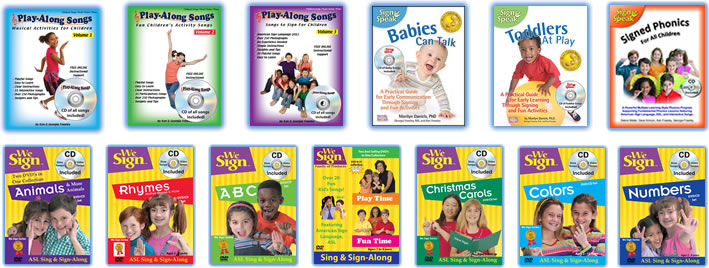
Preschool, Kindergarten and
Elementary School Children’s Songs
How to effectively use children's activity songs.
Preschool Songs:
Preschool songs are for children from 3 years to 5 years of age. Preschool song can offer many benefits during this important stage of development.
The best preschool songs are songs that involve preschoolers by singing along, moving along, and using their creative imaginations. Preschool songs should be fun and playful and at the same time they can challenge their physical abilities, language and vocabulary skills, and support early learning of many core concepts needed for reading readiness and for beginning elementary school.
Play-Along Songs feature new and traditional preschool songs that have proven to engage, educate, and entertain preschool children in a fun and playful way. Watch this demonstration of a preschool song from Play-Along Songs Volume 1 that offers a musical activity that teaches preschoolers about opposites. This song is called Open and Close.
Kindergarten Songs:
Kindergarten songs that combine music and core learning are powerful ways for children to learn and remember. For example, teaching the ABCs with the movement of American Sign Language not only helps children to strengthen sight recognition but to separate letters like LMNOP. Watch this demonstration of the instruction and performance of the ABC Signed Song.

K -2 songs:
K-2 children's elementary songs are chosen as fun musical activities that foster an appreciation for and an interest in music and enhance playful activities at home and in school. Here is an example of a traditional American folk and dance song from Play-Along Songs Volume 1 called Old Brass Wagon.

Grades 3-5 choose activity songs for 2 main reasons also.
- First, like for K, 1 and 2, children's elementary songs are chosen for their fun and playful activities that help on rainy days and foster an appreciation for and an interest in music. Often these are silly songs with lots of movements like this one from Play-Along Songs Volume 1. The song is called I’m a Little Piece of Tin.

- The Second most common reason for choosing elementary songs is to support seasonal activities and that can be used in classroom as well as for all school assemblies. Watch this instruction and demonstration of a classic Christmas Holiday song from our Play-Along Songs Volume 3 called We Wish You a Merry Christmas.

Nine Important Insights
Nine important preschool and elementary school songs insights
- You need no musical background to use and perform preschool songs. Everyone can easily learn to use preschool songs with preschoolers. Preschool songs are generally simple, repetitive, and easy to sing. Play-Along Songs books with songs, instruction and music along with FREE ONLINE video demonstrations will ensure your success at choosing, learning, and presenting preschool songs to preschoolers.
- Learn and understand the preschool song and activity first. Learn new preschool songs ahead of time so you can be proficient at teaching them. Many books offer instructions that help you understand how to perform the song. Listen to CD or downloadable versions of the songs to learn the melodies. If you can, watch video or live presentation demonstrating a song before introducing preschoolers to songs.
- Teach the actions, concepts and melody first. Start by teaching all the actions or any activity concepts (ie: rhyming) first, before singing the song. Have children mirror your actions or provide you with words or ideas. Watch for proficiency and correct any problems before you move on.
- Teach the melody for preschool and elementary school songs as call and response. Begin by slowly singing or chanting the song in segments, one line at a time, with children repeating after you.
- Talk, chant, or sing the song all together. Talk, chant, or sing the song all together performing all the actions slowly. Usually one time through is good for most children to get the basic idea for the song and how it works. Then pick up the speed as you repeat the song for their proficiency.
- Sing the preschool and elementary school song at tempo a cappella or to music tracks. Once preschoolers are proficient with any song, sing it at tempo. You can use an instrument, sing it a capella, or use a recording of the song. Here is a demonstration for you to watch that demonstrates the basic steps in teaching and then performing a preschool song. This song is in Play-Along Songs Volume 2 and is called Hi Ho the Rattlin’ Bog.

- Keep the activity fun, playful, and engaging. Be enthusiastic and light hearted, sometimes even mischievous, as you engage preschoolers in musical activities. Your enthusiasm not only fosters good adult/child interaction, but also provides a humorous way for children to learn and repeat the learning activity.
- Repeat the children’s songs often. Once you introduce a preschool song it is best to repeat it often to reinforce the learning and memorizing of the song. Children love to repeat enjoyable activities and many of their favorite songs will be performed over and over. Repetition also supports any learning component to a song.
- Encourage your preschool and elementary school students to be creative with each of the activities. Children’s songs as well as folk songs are generally easy to adapt. They are simple, repetitive, and often have only a few words that need to be re-written or changed in order for children to create new actions, lyrics, and even verses. Action and animal sound songs are the easiest to manipulate. Rhyming songs require an understanding of rhyming words (hat-cat) and with that children can re-write words and lyrics to be about anything they want to sing about.
Product Line
